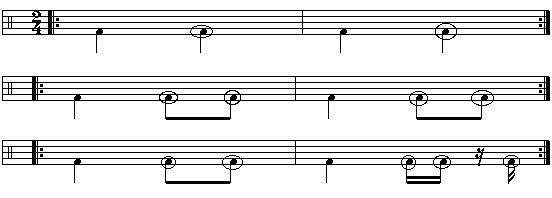"A good drummer listens as much as he plays." ~ Indian Proverb
Percussion Store Drummers Drum Lessons Drumming FAQs
International Shipping
"A good drummer listens as much as he plays." ~ Indian Proverb
Percussion Store Drummers Drum Lessons Drumming FAQs
International Shipping
![]()
![]()
Drums & Percussion
Drum Sets & Cymbals
Cymbals, Hardware & Accessories
Latin Percussion
LP Hardware, Accessories & Replacement Parts
Middle-East Drums & Percussion
African Drums & Accessories
Chinese & Eastern Drums & Percussion
Irish Drums & Percussion
Orchestra Bells & Chimes
Drum & Percussion Hardware
![]()
Samba Rhythms for Samba Percussion
Chuck SilvermanHere you'll find some patterns here which are patterned after typical samba grooves. Every drummer, whether a set player or percussionist, should know about these rhythms. Check 'em out and see if they inspire you to apply them to the set.
This first pattern is for the low surdo. The circled notes are the open sounds. The regular noteheads denote a dampened sound. This surdo part is very important.

Next is the high surdo part. The circled notes are the open sounds. The combination of the high and low drums is a great groove and an important part of samba. The low and high drums are the heartbeat of the groove, with the lower drum being a bit more important. Nevertheless, the mix of the two is very important and fun!

The agogo bells are another great instrument to get into. In my experience it's best not to be agogo bell heavy. The patterns are not that easy so take your time. These are just some guidelines. Of course the two positions of the notes mean different pitches of the bells

This is the tamborim part. It's to be played on the tamborim which
is a relatively high pitched, one headed drum. The tamborim rhythms are an
integral part of samba. This is just one of many tamborim rhythms.
![]()
Click on Chuck Silverman.com for more lessons and for opportunities to study in Brazil and Cuba
![]()